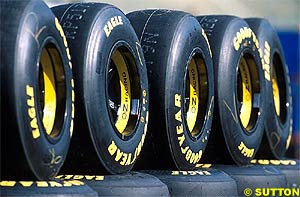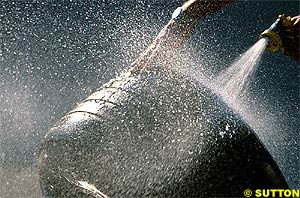
Don't Hold Your Breath for Slicks
Atlas F1 GP Correspondent
Following the modifications introduced to the sporting rules last month, team principals are due to meet again on December 4th to discuss changes to the technical regulations. The measures to be considered are expected to include the banning of some electronic aids and the, unlikely, return of slick tyres. Atlas F1's Gary Emmerson reviews the changes that F1 is likely to undergo next year
Last month, FIA president Max Mosley and the sport's supremo Bernie Ecclestone stepped in to halt dwindling crowd numbers and falling television audiences following a year in which Formula One became Formula Yawn in the light of Ferrari's dominance.
The qualifying format was changed in a bid to spice up what had become a relatively meaningless hour on a Saturday afternoon, while the points system was overhauled to hand teams further down the grid a chance to pick up points finishing as low as eighth. The truth behind the revision, however, was to ensure the race winner was not receiving the four-point advantage he had been.
They decided against a knee-jerk reaction in a bid to stop Schumacher and Ferrari running away with the 2003 Championship, although McLaren-Mercedes are already ruling out any hopes they have of becoming top-dog again.
But at another meeting of the Formula One's Technical Working Group and the team bosses in London on December 4, yet more proposals will lie on the table for discussion over potential changes to the sport's technical regulations, aimed at improving the spectacle and equally saving money in the current financial situation worldwide.
A unanimous vote, of course, will be required from the teams if any of the ideas are to be integrated into the sport, but one thing is guaranteed: they will not be passed in time for 2003, when the Formula One Commission meet on December 15 to finalise regulations for the new season.
"The teams are going to meet at the beginning of December and try and reach unanimous agreement on a whole list of measures that won't make any particular difference on the outside but which will save money and make things much easier, more economical for them," Mosley confirmed.
But Mosley, one of the key critics of the 2002 season in which he admitted having no interest in the outcome of Grands Prix, has already ruled out the prospect of one of the ideas happening, that being the return of slick tyres, because he believes the key aerodynamicists will not agree to the move, which needs a unanimous vote.
Reports emanating from Germany last week suggested that teams are keen for slicks to return for the first time since grooved tyres were brought in in 1998, in the hope of recreating the exciting wheel-to-wheel racing that typified the sport before the technological era took hold.
"I have said to the teams that we would be quite happy to go back to slicks, wide tyres, wide cars, etc, if we had the right to do whatever we wish to the aerodynamics, with the agreement of 50 percent of the teams at six months' notice or without any agreement at all at twelve months' notice," Mosley told Atlas F1 last week.
"I don't think they will agree, but anything else would make an unacceptable escalation in cornering speeds inevitable," he added. "Grooved tyres were probably the most important contribution to keeping speed and therefore safety under control, and the idea of going back to slicks I think is highly unlikely in Formula One."
Formula One cars have taken on a more streamlined, or narrow depending on which you prefer, look in recent years, with the average machine now standing at around 1.80 metres wide compared to the 2.00 metre-wide cars which graced to tracks during the slick tyre era.
For the slick tyres to be re-introduced, and it is highly-unlikely all 11 teams agree to the move, cars would need radically redesigning and aerodynamics would become a major new issue once again. With slicks could potentially come the reduction in wing size, but with bans on testing potentially in place the move appears as likely as Schumacher and Ferrari being beaten next season.
One team insider said: "The idea of slicks coming back, I can't see it happening. It would require cars to be completely redesigned around the tyre and in cost-cutting times that is not necessarily the best thing to happen."
Other ideas, less obvious to the naked eye on track, could also be passed if teams give their vote. Proposals to ban the use of bi-directional telemetry will be on the table for discussion, with Mosley keen on eradicating the increasing influence of technology. "The most obvious example would be that the two-way telemetry with the cars ought probably to be got rid of," Mosley said.
Other proposals include the acceleration of fuel flow during pit-stops from 12 litres per-second to 18 litres per-second decreasing the average stop from between 6-8 seconds to somewhere close to four seconds. The introduction of such a measure would, of course, drastically affect race strategies too.
And further testing proposals are on the cards, if teams agree to them. Testing at Grand Prix circuits such as the Circuit de Catalunya in Barcelona and Silverstone, for example, could be forbidden for one month prior to the Grands Prix dates rather than the two-week period currently in place.
But Ron Dennis, the McLaren-Mercedes-Benz team boss, believes it will be difficult to reach unanimous agreements on any of the ideas for change. Dennis believes the proposals will be "opinion-splitters" among the teams and is unsure over the likelihood of the changes getting a unanimous yes. Of course, all the FIA will say is that the decisions will be revealed next month. Here's waiting for yet more revolutionary changes to liven up the show.
When Formula One's Technical Working Group meet in London in early December, a host of potentially ground-breaking technical changes could be introduced into Formula One for the second time in a month in the hope of bringing entertainment back to a worldwide audience.
 The option of testing time on the Friday morning at a Grand Prix circuit was also offered if teams agreed to test for just 10 days a year, but Mosley, Ecclestone, et al decided against sanctioning radical ideas to introduce ballast to the cars of successful drivers, or even force drivers to compete for all teams on the grid during a single season.
The option of testing time on the Friday morning at a Grand Prix circuit was also offered if teams agreed to test for just 10 days a year, but Mosley, Ecclestone, et al decided against sanctioning radical ideas to introduce ballast to the cars of successful drivers, or even force drivers to compete for all teams on the grid during a single season.
 Equally with the electronics, ideas are in place to ensure all teams on the grid receive a standardised ECU black box, in order to give lesser teams at the wrong end of the grid the same software programming systems as leading outfits of the ilk of Ferrari, who benefit from 24-hour round-the-clock development at their Maranello base.
Equally with the electronics, ideas are in place to ensure all teams on the grid receive a standardised ECU black box, in order to give lesser teams at the wrong end of the grid the same software programming systems as leading outfits of the ilk of Ferrari, who benefit from 24-hour round-the-clock development at their Maranello base.
Please Contact Us for permission to republish this or any other material from Atlas F1.
|
Volume 8, Issue 47
Atlas F1 Exclusive
Interview with Bobby Rahal
Articles
The Arrows Saga Continues
Technical Focus
Columns
Rear View Mirror
Elsewhere in Racing
The Grapevine
> Homepage |